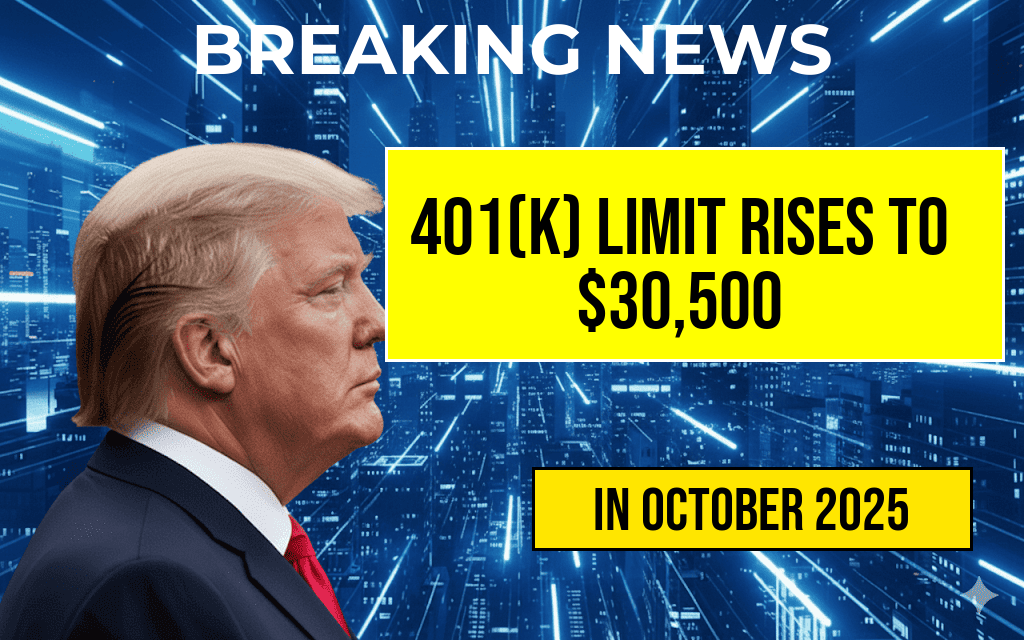The Internal Revenue Service (IRS) has announced a significant increase in the maximum allowable contributions to 401(k) retirement plans for the upcoming year, setting the limit at $30,500 for 2025. This adjustment reflects ongoing efforts to help Americans bolster their retirement savings amid rising living costs and economic shifts. The rise represents a notable jump from the 2024 limit of $22,500, marking one of the largest annual increases in recent history. For individuals aged 50 and older, a catch-up contribution allowance also increases, allowing an additional $7,500 to be contributed, reaching a total of $38,000 in 2025.
Understanding the New Contribution Limits
Details of the 2025 Adjustment
| Limit Type | 2024 | 2025 |
|---|---|---|
| Standard Employee Contribution | $22,500 | $30,500 |
| Catch-up Contribution (age 50 and above) | $7,500 | $7,500 |
| Total Possible Contribution (including catch-up) | $30,000 | $38,000 |
The increase is driven by the IRS’s annual adjustments for inflation, which aim to keep retirement savings contributions aligned with economic growth. The higher contribution limit enables employees to allocate more toward their retirement savings each year, offering a strategic advantage for those seeking to maximize their savings potential.
Implications for Retirement Planning
Financial experts emphasize that the increased limits can significantly impact long-term retirement strategies. “With the contribution cap rising, workers have an opportunity to accelerate their savings,” says Laura Martinez, a certified financial planner based in Chicago. “Maximizing contributions early in one’s career can lead to a more comfortable retirement, especially considering the uncertainties surrounding future Social Security benefits.”
The elevated limit also encourages higher earners to contribute more, especially those who might have previously found the standard cap restrictive. Additionally, the annual increase reflects broader efforts by policymakers to promote retirement readiness among Americans.
Factors Influencing the Limit Increase
Inflation and Economic Factors
The IRS bases its contribution limits on the Chained Consumer Price Index for Urban Wage Earners and Clerical Workers (C-CPI-U), a measure of inflation that accounts for consumer substitution effects. The substantial increase for 2025 stems from higher-than-anticipated inflation rates over the past year, necessitating a larger adjustment to preserve the purchasing power of retirement contributions.
Policy and Legislative Context
While the IRS sets these limits annually, discussions around expanding retirement savings options continue at the federal legislative level. Recent proposals aim to further incentivize retirement contributions, including potential adjustments to catch-up contributions and the introduction of new savings vehicles.
Impact on Employers and Retirement Industry
Employer-Sponsored Plans
Employers offering 401(k) plans must update their plan documents to reflect the new contribution limits. Many plan administrators are already preparing for the transition to 2025, ensuring that participant accounts can accommodate the increased contribution ceilings.
Retirement Industry Trends
Financial institutions and retirement plan providers are likely to promote higher contribution options, emphasizing the importance of early and consistent savings. The increase may also influence the development of new financial products aimed at helping savers reach these higher contribution thresholds.
Additional Considerations for Savers
- Maximizing catch-up contributions: Individuals aged 50 and older should consider contributing the full $7,500 to take advantage of catch-up provisions, further boosting their retirement nest egg.
- Tax implications: Contributions to traditional 401(k) plans are tax-deductible, reducing taxable income for the year of contribution, while Roth 401(k) contributions are made with after-tax dollars but offer tax-free withdrawals in retirement.
- Contribution deadlines: Contributions for 2025 can be made up until the plan’s tax filing deadline, typically April 15, 2026, allowing for strategic year-end planning.
Looking Ahead
As retirement planning continues to evolve in response to economic realities, the increase in contribution limits underscores the importance of proactive savings strategies. Experts recommend reviewing individual retirement plans regularly and consulting with financial advisors to optimize contributions and investment choices. The IRS updates these figures annually, reflecting both inflation and policy priorities, and staying informed ensures savers can make the most of these adjustments.
For further insights into retirement planning and IRS regulations, visit the [IRS official website](https://www.irs.gov) or explore detailed analyses at [Forbes](https://www.forbes.com). As the 2025 contribution limits take effect, Americans are encouraged to reassess their savings plans and consider increasing their contributions to secure a more stable financial future.
Frequently Asked Questions
What is the new 401(k) contribution limit for 2025?
The 401(k) contribution limit for 2025 has increased to $30,500, allowing participants to save more for retirement.
Who is affected by the increased 401(k) contribution limits?
The increase impacts employees and employers who contribute to 401(k) plans, enabling higher annual contributions for eligible participants.
Are there any catch-up contribution provisions for those over 50?
Yes, individuals over 50 years old can make additional catch-up contributions, which are still subject to limits set by the IRS, potentially increasing their total contribution for 2025.
When do the new 2025 contribution limits take effect?
The 2025 contribution limits are effective from January 1, 2025, aligning with the start of the new calendar year.
How does the increase in contribution limits affect retirement savings strategies?
The higher contribution limit provides an opportunity for savers to increase their retirement savings, potentially allowing for a more secure financial future and greater tax advantages.

Leave a Reply